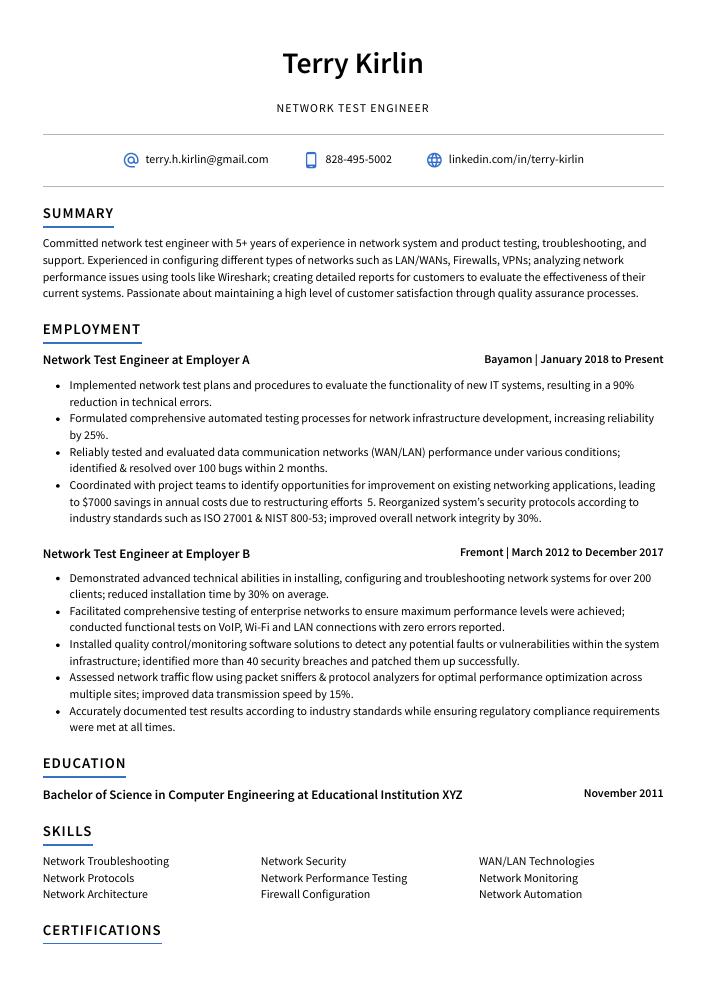Network Test Engineer Resume Guide
Network test engineers are responsible for testing and evaluating network systems to ensure that they meet performance requirements. They use various tools and techniques, such as packet analysis and traffic monitoring, to evaluate the reliability, speed, security, scalability, capacity planning of networks. Additionally, these engineers develop tests plans in order to assess new or updated hardware or software components before deployment.
Your proficiency in network testing and analysis is unrivaled, but employers don’t know that. To make them aware of your skillset, you must write a resume that stands out from the rest.
This guide will walk you through the entire process of creating a top-notch resume. We first show you a complete example and then break down what each resume section should look like.
Table of Contents
The guide is divided into sections for your convenience. You can read it from beginning to end or use the table of contents below to jump to a specific part.
Network Test Engineer Resume Sample
Terry Kirlin
Network Test Engineer
[email protected]
828-495-5002
linkedin.com/in/terry-kirlin
Summary
Committed network test engineer with 5+ years of experience in network system and product testing, troubleshooting, and support. Experienced in configuring different types of networks such as LAN/WANs, Firewalls, VPNs; analyzing network performance issues using tools like Wireshark; creating detailed reports for customers to evaluate the effectiveness of their current systems. Passionate about maintaining a high level of customer satisfaction through quality assurance processes.
Experience
Network Test Engineer, Employer A
Bayamon, Jan 2018 – Present
- Implemented network test plans and procedures to evaluate the functionality of new IT systems, resulting in a 90% reduction in technical errors.
- Formulated comprehensive automated testing processes for network infrastructure development, increasing reliability by 25%.
- Reliably tested and evaluated data communication networks (WAN/LAN) performance under various conditions; identified & resolved over 100 bugs within 2 months.
- Coordinated with project teams to identify opportunities for improvement on existing networking applications, leading to $7000 savings in annual costs due to restructuring efforts 5. Reorganized system’s security protocols according to industry standards such as ISO 27001 & NIST 800-53; improved overall network integrity by 30%.
Network Test Engineer, Employer B
Fremont, Mar 2012 – Dec 2017
- Demonstrated advanced technical abilities in installing, configuring and troubleshooting network systems for over 200 clients; reduced installation time by 30% on average.
- Facilitated comprehensive testing of enterprise networks to ensure maximum performance levels were achieved; conducted functional tests on VoIP, Wi-Fi and LAN connections with zero errors reported.
- Installed quality control/monitoring software solutions to detect any potential faults or vulnerabilities within the system infrastructure; identified more than 40 security breaches and patched them up successfully.
- Assessed network traffic flow using packet sniffers & protocol analyzers for optimal performance optimization across multiple sites; improved data transmission speed by 15%.
- Accurately documented test results according to industry standards while ensuring regulatory compliance requirements were met at all times.
Skills
- Network Troubleshooting
- Network Security
- WAN/LAN Technologies
- Network Protocols
- Network Performance Testing
- Network Monitoring
- Network Architecture
- Firewall Configuration
- Network Automation
Education
Bachelor of Science in Computer Engineering
Educational Institution XYZ
Nov 2011
Certifications
Cisco Certified Network Professional (CCNP)
Cisco Systems
May 2017
1. Summary / Objective
Your resume summary/objective should be a concise, yet compelling overview of your qualifications as a network test engineer. For example, you could mention the certifications and experience you have in testing networks for performance issues, the automation tools you are proficient with, or how quickly and accurately you can troubleshoot complex problems. Your summary should give employers an idea of why they should hire you over other candidates.
Below are some resume summary examples:
Seasoned network test engineer with 10+ years of experience in developing and executing comprehensive testing strategies for large-scale enterprise networks. Proven track record of identifying issues quickly, implementing solutions to maximize network performance, and reducing downtime by 28%. Eager to join ABC Tech as the next Network Test Engineer where I can help increase customer satisfaction through effective troubleshooting and problem solving.
Energetic network test engineer with 5+ years of experience in planning, designing, and executing network tests. Skilled at troubleshooting complex network issues across multiple platforms to ensure the highest level of system performance. Successfully identified and resolved critical hardware/software compatibility problems for ABC Corporation that saved $10K in downtime costs. Looking to leverage my expertise into a senior position at XYZ Inc.
Skilled network test engineer with 10+ years of experience developing and implementing comprehensive testing strategies for networks. Passionate about ensuring optimal performance and stability of products through rigorous quality assurance processes. At XYZ, implemented an automated end-to-end network testing suite that reduced regression time by 43%. Looking to join ABC Tech as a Network Test Engineer to contribute my expertise in this field.
Dependable network test engineer with 10+ years of experience designing, testing and maintaining local area networks. Skilled in debugging network problems using a variety of software tools and techniques. At DEF Corp., developed an automated diagnostic tool to detect errors in system performance that increased the accuracy of results by 50%. Looking forward to joining ABC Tech’s networking team as a Senior Network Test Engineer.
Amicable and experienced network test engineer with 5+ years of experience in the telecom industry. Specializing in diagnosing and troubleshooting hardware, software, and system issues to ensure optimal performance. Skilled at conducting comprehensive testing on all types of networks including LANs, WANs, wireless networks, VoIP systems etc. Experienced in using various tools like Kali Linux for penetration testing and analysis.
Reliable network test engineer with 5+ years of experience in testing, troubleshooting, and maintaining network systems. Skilled at analyzing log files to detect errors and identify system bottlenecks. Experienced in developing and implementing automated tests for various applications. At XYZ, consistently met deadlines while managing a team of 10 engineers tasked with meeting complex customer needs within budget constraints.
Detail-oriented network test engineer with 8+ years of experience in developing and implementing automated tests for large-scale networks. Experienced in troubleshooting software and hardware issues, preparing reports on network performance, and analyzing system requirements. Seeking to join ABC Tech as a Network Test Engineer to use my technical knowledge to ensure the highest quality of products delivered.
Enthusiastic network test engineer with 4+ years of experience developing and executing comprehensive network testing plans. Possess a strong understanding of networking protocols, hardware/software integration, and troubleshooting techniques to identify and resolve issues quickly. At ABC Tech, reduced system outages by 32% through rigorous analysis and effective problem-solving strategies.
2. Experience / Employment
In the experience section, you should provide details on your work history. This section should be written in reverse chronological order, meaning the most recent job is listed first.
When writing this section, stick to bullet points primarily; it makes it easier for the reader to take in what you have said quickly and effectively. You want to think about providing detail when writing these bullet points – explain what you did and any quantifiable results that were achieved as a result of your efforts.
For example, instead of saying “Tested network performance,” you could say, “Performed regular tests on LAN/WAN networks using various protocols such as TCP/IP and UDP resulting in 99% uptime.”
To write effective bullet points, begin with a strong verb or adverb. Industry specific verbs to use are:
- Configured
- Monitored
- Analyzed
- Troubleshot
- Tested
- Implemented
- Documented
- Resolved
- Optimized
- Evaluated
- Upgraded
- Installed
- Investigated
- Secured
Other general verbs you can use are:
- Achieved
- Advised
- Assessed
- Compiled
- Coordinated
- Demonstrated
- Developed
- Expedited
- Facilitated
- Formulated
- Improved
- Introduced
- Mentored
- Participated
- Prepared
- Presented
- Reduced
- Reorganized
- Represented
- Revised
- Spearheaded
- Streamlined
- Structured
- Utilized
Below are some example bullet points:
- Upgraded network protocols and systems to ensure compatibility with new hardware, achieving a 10% improvement in system speed.
- Evaluated network performance by conducting extensive tests including packet loss analysis, latency checks, throughput measurements; identified and solved over 30 network issues within six months.
- Monitored server uptime closely for 100+ clients on a daily basis; quickly detected problems and implemented solutions that maximized server availability rate of 99%.
- Confidently conducted troubleshooting tasks such as switching cables between servers, resetting IP addresses & protocols etc., ensuring smooth operations of networks at all times.
- Introduced high-level automation testing techniques to the existing process which resulted in improved test coverage by 20%, thereby reducing time spent on manual testing activities significantly.
- Documented, tested and troubleshot 25+ network issues on a daily basis, resulting in successful resolution of over 95% of the cases.
- Achieved an average response time reduction from 3 hours to 15 minutes when resolving network connectivity problems for critical applications; saved $50,000 annually in downtime costs.
- Successfully installed and configured 50+ switches/routers for new branch offices within 2 weeks as part of large-scale projects; reduced long-term maintenance costs by 10%.
- Mentored junior engineers on best practices related to testing & troubleshooting networks with software tools such as Wireshark and Ping Plotter Plus+.
- Conducted routine checks using automated test suites to identify potential vulnerabilities across all server nodes before they materialize into major security breaches or outages; safeguarded company data against external attacks at all times.
- Represented the organization in network design and testing of protocols, systems, and services; improved overall system performance by 20% through rigorous testing.
- Analyzed over 500 customer-reported network issues to determine root cause within 24 hours; reduced downtime for customers by 80%.
- Reduced latency across the entire enterprise LAN/WAN infrastructure by 15%; implemented process improvements that enabled better visibility into system health metrics.
- Revised existing test cases on a regular basis to ensure conformance with latest industry standards; conducted thorough stress tests of networks using automated scripts and manual procedures as necessary.
- Thoroughly documented all findings from each stage of the development life cycle, enabling faster resolution times for any future issues encountered in production environments.
- Expedited network testing of applications and infrastructure for over 20 clients, resulting in a 25% decrease in time to market.
- Prepared detailed reports on performance metrics and system reliability by running automated scripts; identified and mitigated potential issues that could lead to downtime.
- Improved network throughput by 10-20 times through optimization strategies, such as segmentation and load balancing techniques.
- Utilized analytical tools including Wireshark, Nmap & SNMP monitoring solutions to troubleshoot hardware compatibility issues; achieved 100% uptime across all networks within 3 months of joining the organization.
- Efficiently managed firewall configurations for numerous locations while maintaining consistent security standards across multiple platforms; reduced vulnerability exposure rate by 38%.
- Diligently tested, analyzed and troubleshot existing network configurations to identify performance issues; improved system reliability by 30% within the first 6 months of employment.
- Optimized router settings for a variety of networks and implemented new security protocols that allowed access to resources without compromising data integrity; increased efficiency by 45%.
- Advised members of IT teams on best practices when it came to networking systems design, maintenance & upgrades; trained 8 employees in network administration processes.
- Spearheaded the development of automated testing tools used for long-term monitoring purposes which significantly reduced assessment time from 48 hours down to 24 hours per task completed.
- Streamlined hardware installation procedures across multiple sites, reducing setup times from 4 hours per device down to 2 while ensuring full functionality at all locations (+100 devices).
- Tested and evaluated hardware and software of local area networks (LANs) while ensuring high performance, security and reliability; lowered network downtime by 45%.
- Presented detailed system maintenance reports to senior management on a weekly basis, highlighting any issues with the existing LAN systems.
- Participated in regular conferences with vendors for selecting appropriate networking equipment and keeping up-to-date on new technologies; reduced acquisition costs by 11%.
- Configured routers, switches & firewalls according to customer requirements while troubleshooting technical problems as they arose; increased efficiency of company’s IT infrastructure by 33%.
- Substantially improved data transfer rates across all departments through analysis & configuration of TCP/IP protocols such as DNS, DHCP & FTP within 24 hours from initial diagnosis period.
- Secured network infrastructure for 3 major clients by testing and diagnosing performance issues, resulting in a 20% increase in system uptime.
- Developed detailed test plans to ensure the quality of all new hardware/software deployments; successfully implemented 30+ projects within prescribed budgets and timelines.
- Compiled network status reports on a daily basis that tracked the availability, latency & throughput of multi-vendor systems; identified & resolved over 50 technical problems with minimal downtime incurred to customers.
- Proficiently utilized various diagnostic tools (such as Wireshark) to monitor traffic across local area networks and wide area networks, recommending optimizations when necessary for maximum efficiency gains (+20%).
- Investigated reported system failures or outages quickly to determine root cause analysis through packet captures, log files review & server history tracking while communicating findings clearly with IT teams involved.
3. Skills
Skill requirements will differ from employer to employer – this can easily be determined via the job advert. Organization ABC may require the candidate to be knowledgeable in Python, while Organization XYZ may emphasize knowledge of Cisco technologies.
In order to ensure that your resume is seen by a human being, you need to tailor it specifically for each job posting and include relevant keywords from the advert in your skills section. This will help applicant tracking systems (ATS) identify you as an ideal match for that particular role.
You can also further elaborate on these skillset by discussing them more thoroughly in other areas such as the summary or experience sections of your resume.
Below is a list of common skills & terms:
- Firewall Configuration
- Network Architecture
- Network Automation
- Network Monitoring
- Network Performance Testing
- Network Protocols
- Network Security
- Network Troubleshooting
- Network Virtualization
- WAN/LAN Technologies
4. Education
Including an education section on your resume will depend on how far along you are in your career. If you just graduated and have no work experience, mention your education below your resume objective. On the other hand, if you have significant experience working as a network test engineer or similar roles that demonstrate technical knowledge of networks and systems, omitting the education section is perfectly fine.
If an education section is included, try to list courses related to networking and system engineering relevant for the role you are applying for.
Bachelor of Science in Computer Engineering
Educational Institution XYZ
Nov 2011
5. Certifications
Certifications demonstrate to potential employers that you have the necessary knowledge and skills for a particular job. They can also show that you are committed to staying up-to-date with industry trends, as certifications often require regular renewal or reexamination.
Including your certifications on your resume is an excellent way of demonstrating your qualifications and expertise in a certain field. This could give you an edge over other applicants who may not possess such credentials.
Cisco Certified Network Professional (CCNP)
Cisco Systems
May 2017
6. Contact Info
Your name should be the first thing a reader sees when viewing your resume, so ensure its positioning is prominent. Your phone number should be written in the most commonly used format in your country/city/state, and your email address should be professional.
You can also choose to include a link to your LinkedIn profile, personal website, or other online platforms relevant to your industry.
Finally, name your resume file appropriately to help hiring managers; for Terry Kirlin, this would be Terry-Kirlin-resume.pdf or Terry-Kirlin-resume.docx.
7. Cover Letter
Writing a cover letter is a great way to give yourself an edge when applying for jobs. It is usually made up of 2-4 paragraphs and gives you the opportunity to express your personality, highlight your qualifications and explain why you are the best fit for the job.
Cover letters aren’t always necessary but they can help make a good impression on potential employers if done right. They also provide recruiters with more insights into who you are as an individual and what makes you stand out from other applicants.
Below is an example cover letter:
Dear Jacklyn,
I am interested in the Network Test Engineer position at [company name]. With my experience in designing, implementing, and testing network solutions for a variety of clients, I am confident that I would be a valuable asset to your team.
In my current role as a Network Test Engineer at [company name], I work with clients to understand their networking needs and design solutions that meet those needs. I then create test plans to ensure that the networks are functioning properly before they are deployed. Once the networks are up and running, I monitor them closely and troubleshoot any issues that arise.
My experience has taught me how to think outside the box to find creative solutions to complex problems. My attention to detail ensures that all aspects of the network solution are tested thoroughly before deployment. And my strong communication skills allow me to effectively communicate with clients and other members of the team.
I believe that my skills and experience make me an ideal candidate for this position. I am eager to put my knowledge and expertise to work for your company and contribute to your success. Thank you for your consideration, and I look forward to hearing from you soon.
Sincerely,
Terry
Network Test Engineer Resume Templates
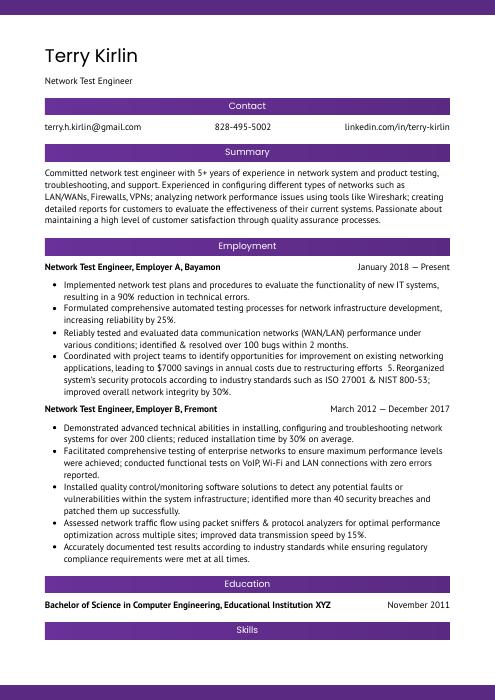 Jerboa
Jerboa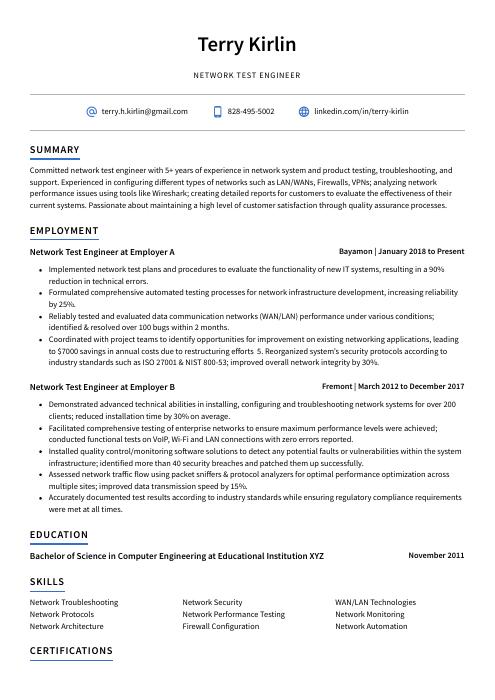 Axolotl
Axolotl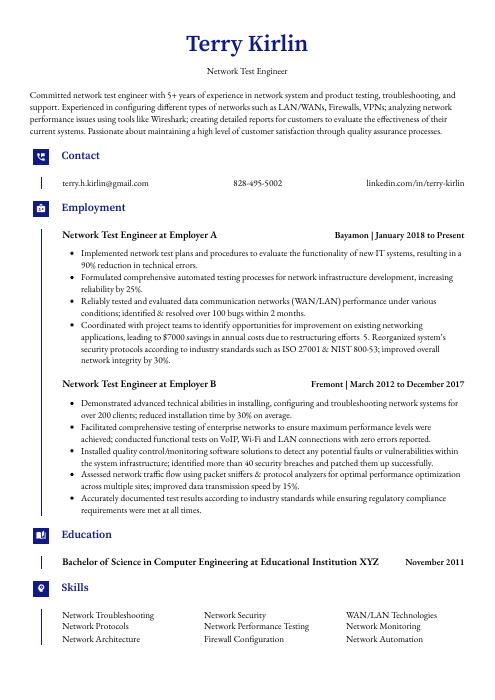 Gharial
Gharial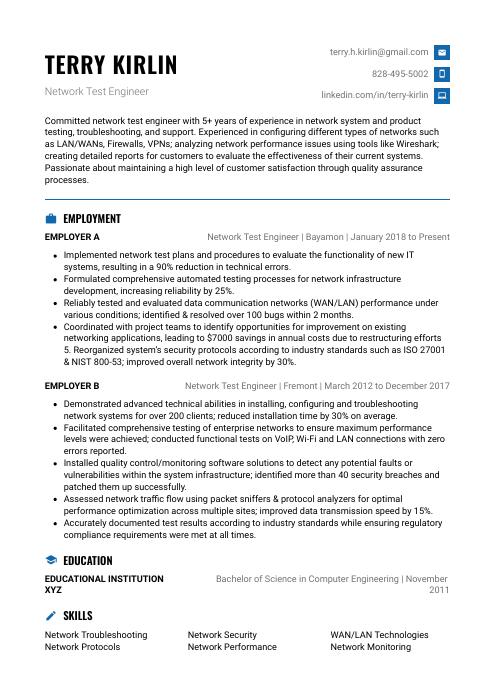 Echidna
Echidna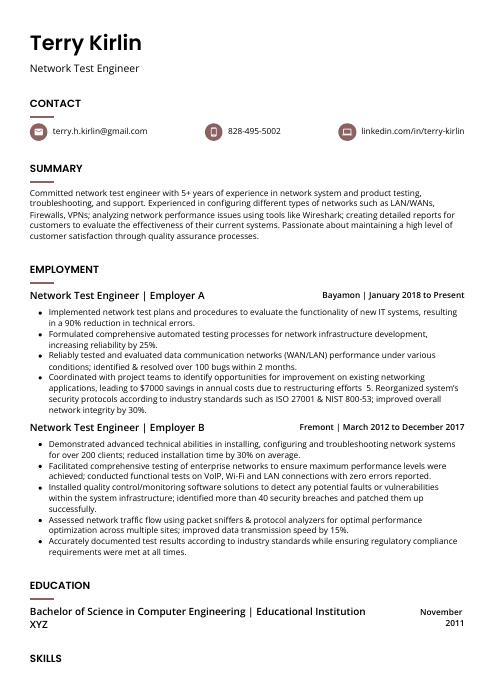 Fossa
Fossa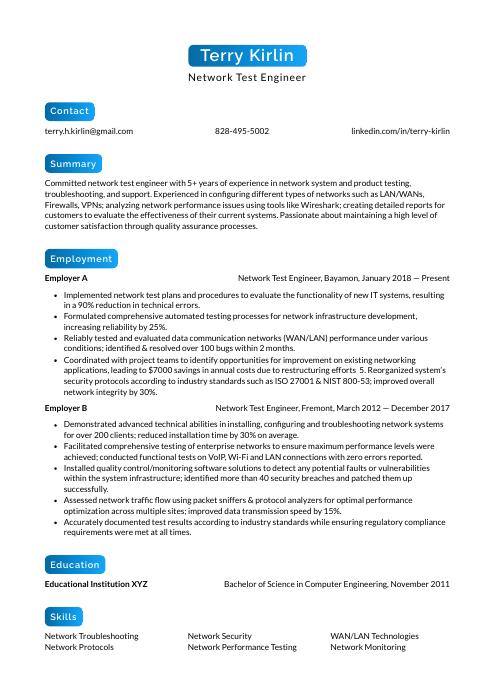 Kinkajou
Kinkajou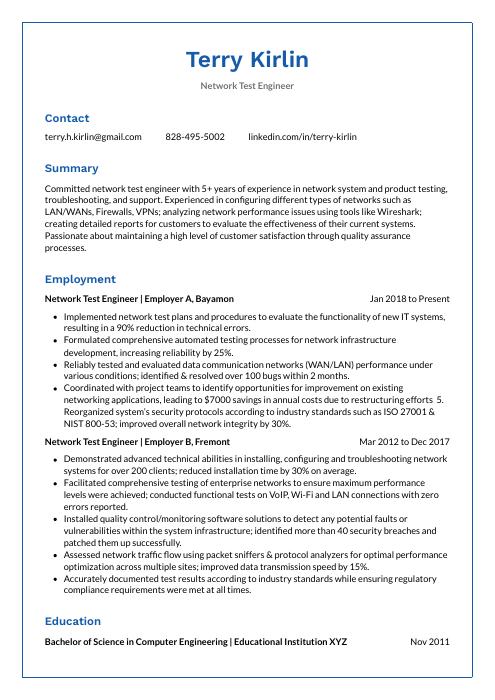 Markhor
Markhor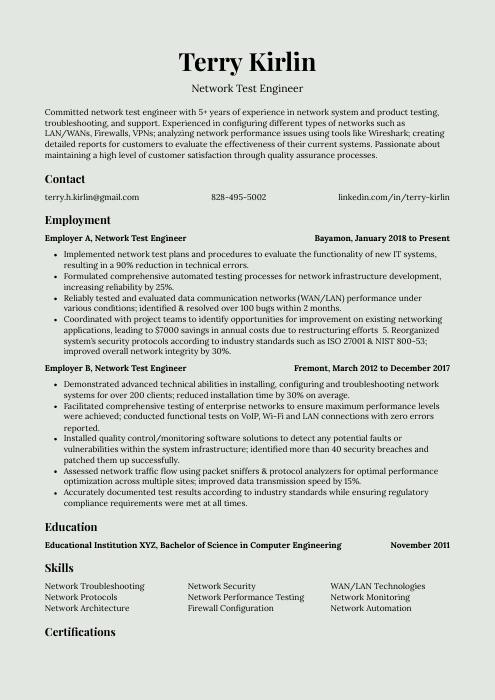 Saola
Saola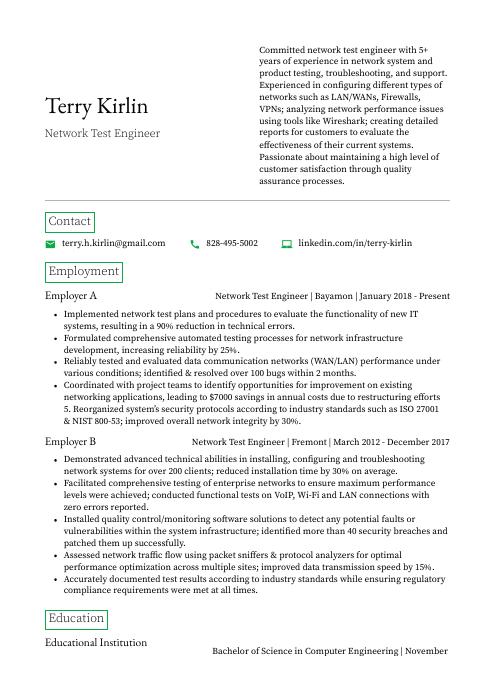 Quokka
Quokka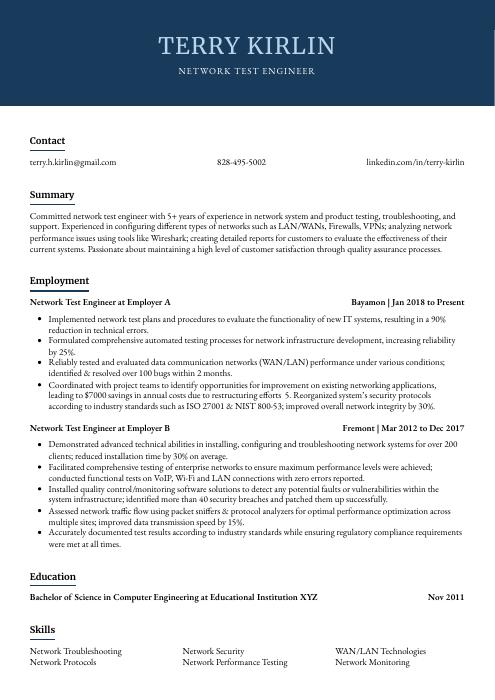 Bonobo
Bonobo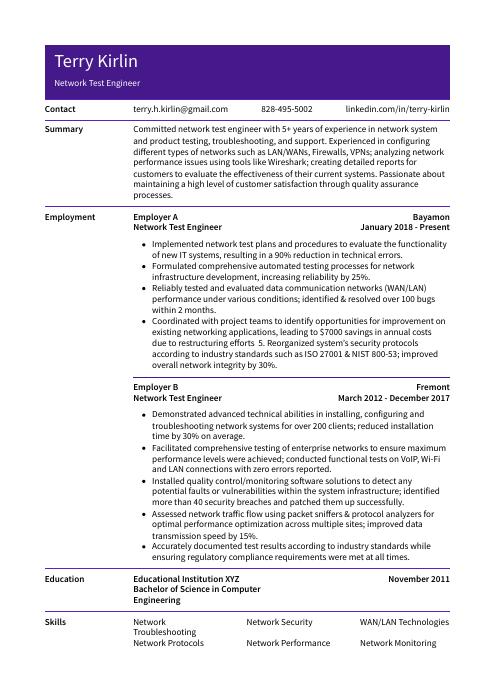 Pika
Pika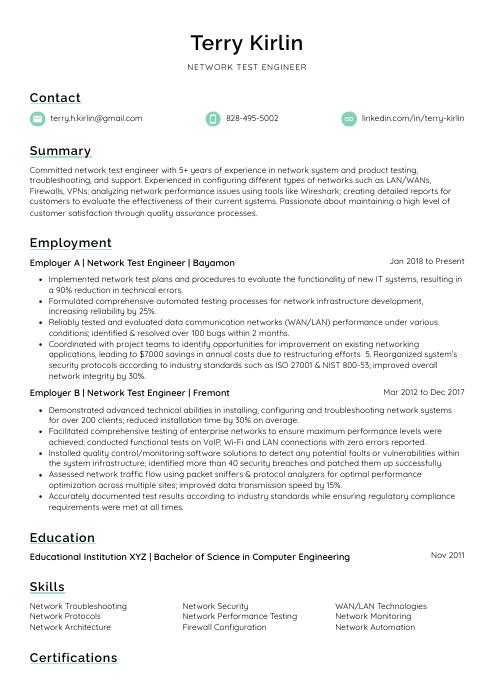 Lorikeet
Lorikeet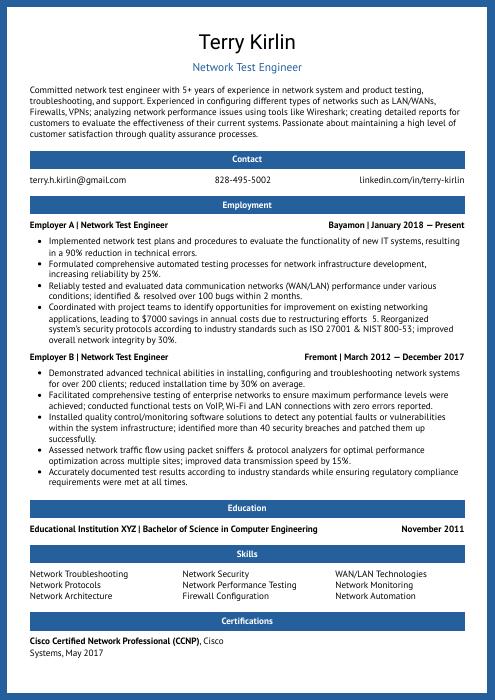 Ocelot
Ocelot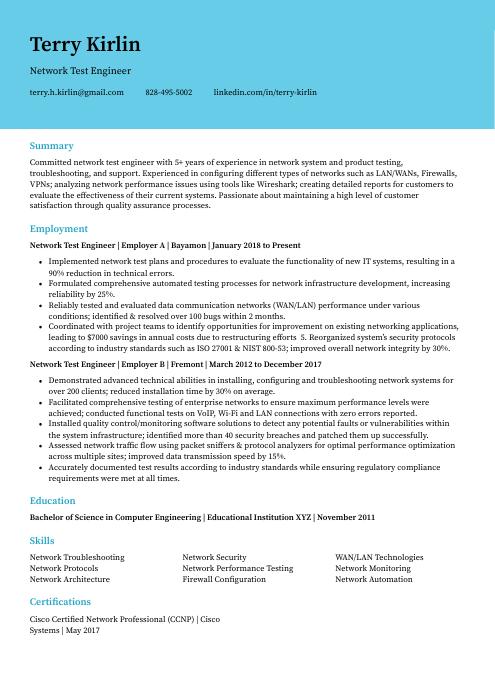 Dugong
Dugong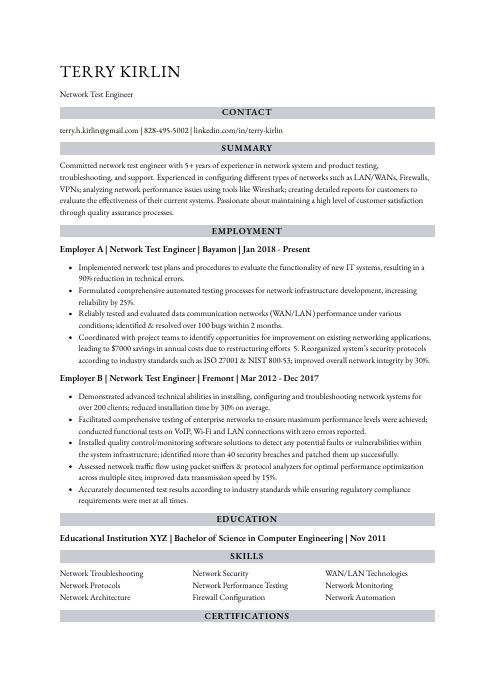 Numbat
Numbat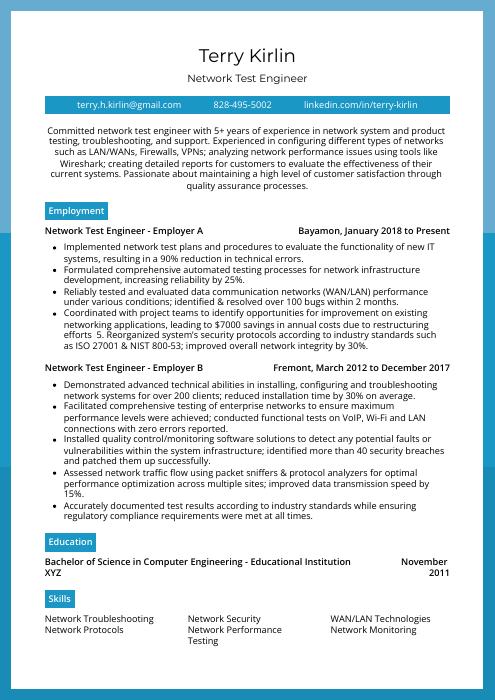 Rhea
Rhea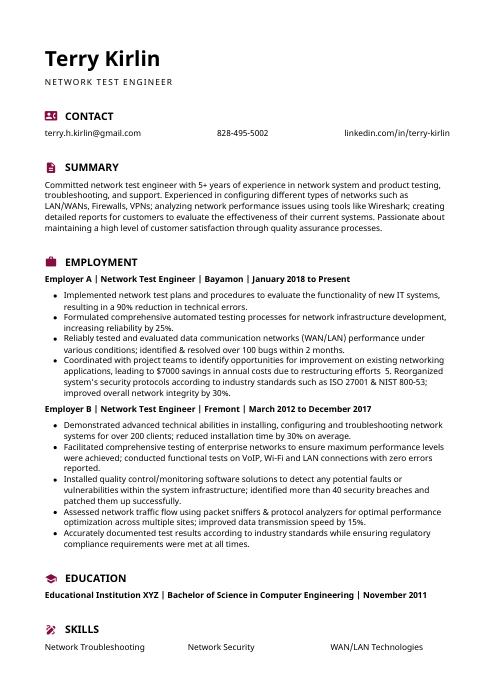 Hoopoe
Hoopoe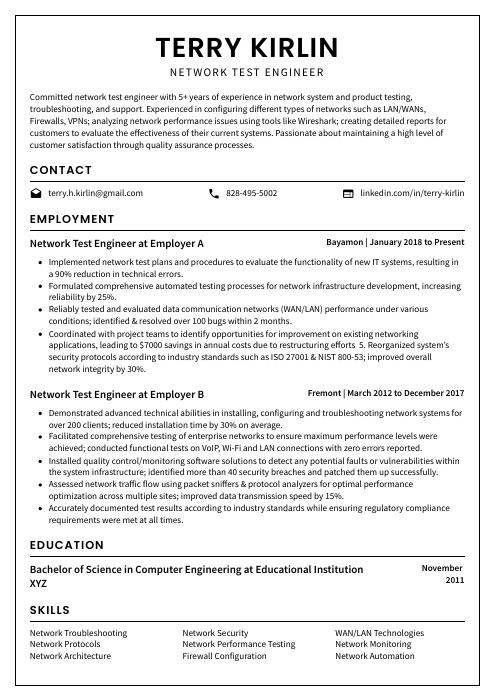 Cormorant
Cormorant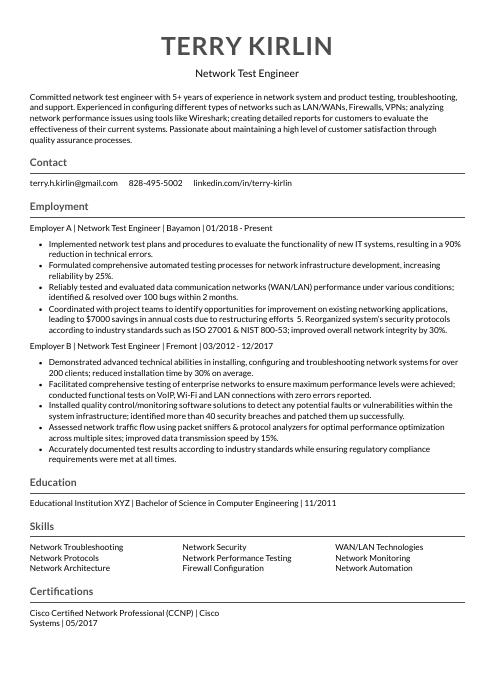 Indri
Indri Rezjumei
Rezjumei
